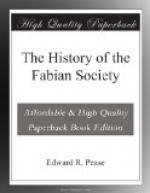reported us.[13] Eighteen papers were read, two
of them by members of Parliament, and most of the
rest by well-known people. William Morris and
Dr. Aveling read papers as delegates from the Socialist
League; the National Secular Society sent Mr. Foote
and Mr. [John M.] Robertson,[14] the latter contributing
a ‘Scheme of Taxation’ in which he anticipated
much of what was subsequently adopted as the Fabian
program; Wordsworth Donisthorpe took the field
for Anarchism of the type advocated by the authors
of ‘A Plea for Liberty’; Stewart Headlam
spoke for Christian Socialism and the Guild of
St. Matthew; Dr. Pankhurst dealt with the situation
from the earlier Radical point of view; and various
Socialist papers were read by Mrs. Besant, Sidney
Webb, and Edward Carpenter, besides one by Stuart
Glennie, who subsequently left us because we fought
shy of the Marriage Question when revising our ‘Basis.’
I mention all this in order to show you how much more
important this abortive Conference looked than the
present one. Yet all that can be said for
it is that it made us known to the Radical clubs
and proved that we were able to manage a conference
in a businesslike way. It also, by the way,
showed off our pretty prospectus with the design
by Crane at the top, our stylish-looking blood-red
invitation cards, and the other little smartnesses
on which we then prided ourselves. We used
to be plentifully sneered at as fops and arm-chair
Socialists for our attention to these details; but
I think it was by no means the least of our merits
that we always, as far as our means permitted,
tried to make our printed documents as handsome
as possible, and did our best to destroy the association
between revolutionary literature and slovenly printing
on paper that is nasty without being cheap.
One effect of this was that we were supposed to
be much richer than we really were, because we generally
got better value and a finer show for our money
than the other Socialist societies."[15]
Three members of Parliament, Charles Bradlaugh, William
Saunders, and Dr. G.B. Clark, took part.
The Dr. Pankhurst mentioned was the husband of Mrs.
Pankhurst, later the leader of the Women’s Social
and Political Union.
The reference in the foregoing passage to the report
on “The Government Organisation of Unemployed
Labour,” prepared concurrently with the organisation
of the Conference, is by no means adequate. The
Report attracted but little attention at the time,
even in the Society itself, but it is in fact the
first typically Fabian publication, and the first
in which Sidney Webb took part. Much subsequent
experience has convinced me that whenever Webb is
on a committee it may be assumed in default of positive
evidence to the contrary that its report is his work.
Webb however maintains that to the best of his recollection
the work was shared between Podmore and himself, the
simple arrangement being that Podmore wrote the first
half and Webb the second. The tract is an attempt




